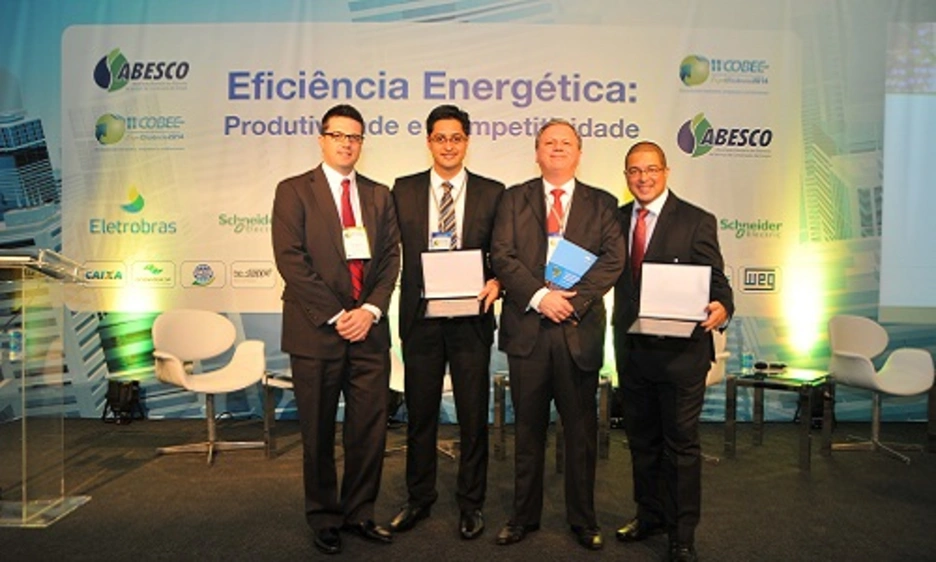How can banks jump-start Brazil's energy efficiency market?

[caption id="attachment_1698" align="alignleft" width="300"] From left to right, representatives of the IDB, APS, ATLA Consultoria and Contax[/caption]
From left to right, representatives of the IDB, APS, ATLA Consultoria and Contax[/caption]
The training was timed to coincide with a conference designed specifically for the development of the Brazilian energy efficiency market organized by the Association of Energy Efficiency Companies of Brazil (ABESCO). The conference (COBEE) provided an opportunity to learn about innovative energy efficient projects, culminating in the presentation of the national award “Qualiesco.” This recognizes best projects of certified energy service companies (ESCOS) in the country.
Both days were filled with interactive sessions where participants took part in both the training and the ABESCO conference, deepening their knowledge on how to finance energy efficiency in Brazil.
One perfect example of how banks can sponsor energy efficiency projects is the story of the winners of the 2014 Qualiesco award. They won for Best ESCO project on a National Scale: a partnership between Contax and APS Soluçoes, backed by the IDB and a Brazilian commercial bank.
Contax, a provider of customer service solutions, manages a call center that has 24/7 operations in Fortaleza. The company had been saddled with monthly fines because of its inability to meet minimum requirements for CO2 emission reduction and was also constrained by increasing energy costs in the country. APS Soluçoes, a small energy service company in Brazil, was able to offer Contax monthly savings in their energy costs by renovating their lighting and air conditioning systems. APS could guarantee Contax a fixed amount of savings per month. But, in order to follow through with its client and achieve the desired savings, APS needed to find short-term financing for about a third of the total project cost.
APS was able to receive an Energy Efficiency Guarantee Mechanism (EEGM) letter of guarantee for 80 percent of the investment. Having the IDB as a guarantor of 80 percent of the needed investment made the risk much lower for Banco Indusval & Partners (BI&P). This allowed BI&P to provide the financing to APS and make the project bankable.
Here are two trends that APS and Contax were able to foresee to make this project successful:
1. Energy efficiency is an untapped markets for banks:
Brazil, like much of Latin America, is not taking sufficient advantage of its potential in energy efficiency. It remains an untapped resource, one toward which banks are starting to gravitate. The typical energy efficient project needs lending on a smaller scale and over a longer period of time, and even though initially it might not seem an attractive investment for a commercial bank, the training helped prove otherwise. Using real case studies and introducing financial tools at their disposal, such as the Energy Efficiency Guarantee Mechanism, the sessions demonstrated how banks can mitigate the risks associated with energy efficiency projects, see in real numbers the consistent return these projects can generate, and overcome typical barriers to investment
2. There is room to grow:
Energy prices are a growing concern in Brazil.The Central Bank of Brazil recently released estimate increases in electricity pricing of 6.5 and 5.7 percent for 2014 and 2015, respectively. Some private forecasting firms project price readjustments that are considerably higher—with increases of up to 20 percent for 2015. Given this scenario, companies should act preemptively. Reducing energy costs should be a priority for many companies that cannot afford this steadily growing operational cost. Energy efficiency projects can be implemented relatively easily and can prove lucrative in the long run. The time to invest in these measures is before price increases further damage a company’s balance sheet and impede growth.
Both companies were able to anticipate these trends. They decided to use a new financial tool that would allow the bank to back their project and bring it to fruition. There is no reason why the EEGM cannot support more ESCOs like APS and more clients like Contax finance sustainable solutions and increase their bottom line.
LIKE WHAT YOU JUST READ?
Subscribe to our mailing list to stay informed on the latest IDB Invest news, blog posts, upcoming events, and to learn more about specific areas of interest.
Subscribe



